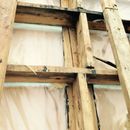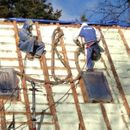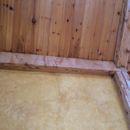Unvented cathedral ceiling condensation issues
Hi there,
I received a call form one of my Architect clients. His friend recently re-built his roof and now has major condensation issues; so I went to take a look. Here is the constructed assembly as best as I can figure, pictures attached.
Inside to Outside
1. Heavy timbre with wood cladding in between
2. 6mm poly that wasn’t removed attached to the heavy timbre’s with acoustical sealant and staples
3. From here the old roof was removed from the outside. Between the heavy timbre’s polyiso was tuck taped to the timbres to give the foamer something to spray against.
4. 4″ of closed cell spray foam was applied from the outside, again see pictures. Foam applied over heavy timbres and in between the 2×6’s running parallel and perpendicular on top of the heavy timbres. 2×4’s then on top of the 2×6’s.
5. plywood sheathing
6. felt underlayment
7. Armadillo metal roof
The home owner had condensation issues before the roof repair, now the condensation issue is worse. We are in a 7A zone, Prince Edward Island Canada so I know the R26 from the foam is just not cutting it.
I have a few concerns, first is the double vapor barrier. When we took down a section of the interior cladding to take a look, there was no signs of condensation between the 6mm poly and the poyiso.
Second is the fact that there is a void area between the roof sheathing and the spray foam.
My original thought was the condensation was due to air leakage and freezing on the warm side of the roof sheathing. I was hoping we could take off the metal roof, slap some xps foam in three layers on the roof sheathing, re-install the roof and that would take care of the issue. However I was informed by the roofer that the new roof is not coming off without destroying it.
Now my approach would be to add additional interior insulation and a smart vapour retarder.
Am I missing something or am I on the right track. I would like a second opinion and also think a WUFI analysis wouldn’t hurt as well.
Best regards,
Kris.
GBA Detail Library
A collection of one thousand construction details organized by climate and house part












Replies
Kristopher,
You wrote, "Now the condensation issue is worse." What does that mean? Where is condensation appearing?
In theory, the closed-cell spray foam should have created an effective air barrier, unless there was an installation error. So it's not clear to me what's going on here.
Needless to say, 4 inches of closed-cell spray foam has a relatively low R-value -- only R-24 to R-26. But a low R-value won't lead to condensation, as long as there is an air barrier that prevents warm humid air from contacting cold surfaces.
Thanks for the reply Martin, I was hoping you would answer. The owner had the same issue before the spray foam was installed (this January). The original ceiling was fiberglass batts. He was advised that the spray foam would take care of the issue, it however did not and the owner feels the condensation problems are worse that before. The condensation is appearing on the interior roof and running down to the wall, it seems to be mostly around the heavy timbers.
Then issue arises when the temperature drops outside (tends to occur around -10C or lower), the next day when it warms up, the condensation appears. They tend to keep the indoor temp around 22C. I advised to replace their filer on their HRV and to make sure its operating on max for now but let them know that this is not the fix, only a band-aid.
The only thing I can think of is air leakage, its a real head scratcher. Would really appreciate any advice.
Kris.
Kristopher,
A blower door test would help assess the air leakage through the roof assembly. Depending on whether the spray foam installers were paying close attention to their work, there could easily have been opportunities for air leakage.
For example, what was done around the skylight shown below?
.
I think Martin is spot on in suggesting air leakage. The 2x4's on top of the 2x6's are leaving a 1-1/2" air gap above the foam. Any warm air leakage from the envelope in the temps you mentioned is going to cause condensation to form.
What does the roof assembly look like where the roof line meets the walls? If the air gaps at the intersection of the roof line and supporting wall was left open and not completely sealed this could be the main source of your leakage.